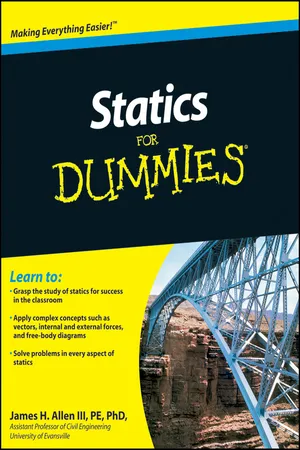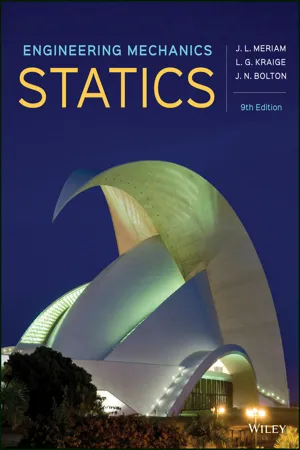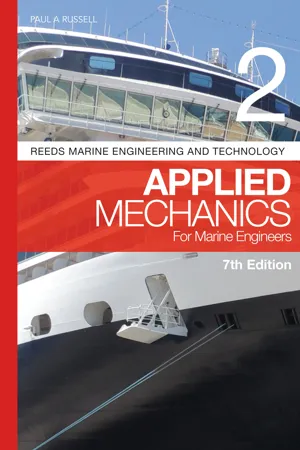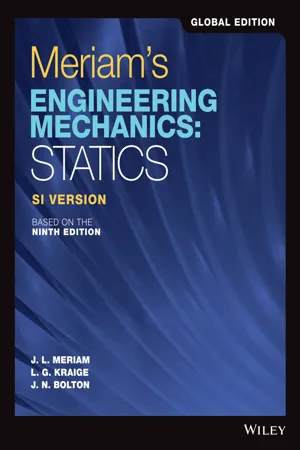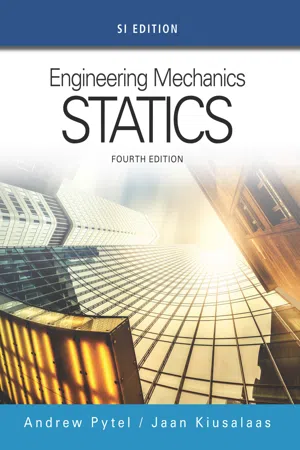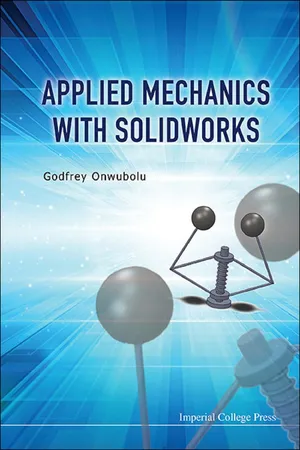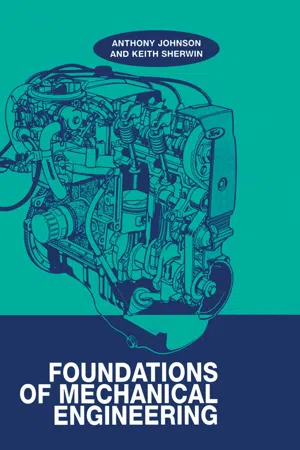Technology & Engineering
Statics
Statics is a branch of mechanics that deals with the study of objects at rest or in a state of equilibrium under the action of external forces. It focuses on analyzing the forces acting on structures and objects to determine their stability and balance. In engineering, statics is essential for designing and constructing stable and safe structures.
Written by Perlego with AI-assistance
Related key terms
1 of 5
8 Key excerpts on "Statics"
- eBook - ePub
- James H. Allen, III(Authors)
- 2010(Publication Date)
- For Dummies(Publisher)
Part I Setting the Stage for StaticsIn this part . . .This first part introduces you to the basic concepts of mechanics in engineering and the sciences, as well as the differences between the basic fields. You also pick up the basic assumptions you need when working Statics problems. I explain the two primary systems of units (U.S. customary and metric) and introduce you to the base units of each system. Finally, I review basic algebra, geometry, trigonometry, and calculus, all of which you encounter frequently in Statics.Passage contains an image
Chapter 1 Using Statics to Describe the World around You In This Chapter Defining Statics and related studies Introducing vectors Exploring free-body diagrams Looking at specific applications of StaticsStatics is a branch of physics that is especially useful in the fields of engineering and science. Although general physics may describe all the actions around you, from the waving of leaves on a tree to the reflection of light on a pond, the field of Statics is much more specific.In fact, Statics is actually a part of most physics courses. So if you’ve ever taken a high school or college physics course, chances are that some of the information in this book may seem vaguely familiar. For example, one of the first areas you study in physics is often Newtonian mechanics, which is basically Statics and dynamics.Physics classes typically cover a wide range of topics, basically because physics has a wide range of applications. Conversely, a Statics course is much more focused (which doesn’t necessarily mean it’s simple). Whoever said that the devil is in the details may well have been talking about Statics.Before you panic, close the book, and begin questioning why you ever thought you could understand Statics, let me reassure you that just because Statics isn’t always simple doesn’t mean it’s always difficult. If anything, Statics does happen to be very methodical. If you follow some basic steps and apply some basic ideas and theory, Statics actually can become a very straightforward application process. - eBook - PDF
Engineering Mechanics
Statics
- James L. Meriam, L. G. Kraige, J. N. Bolton(Authors)
- 2018(Publication Date)
- Wiley(Publisher)
Substantial By Duke.of.arcH - www.flickr.com/photos/dukeofarch/Getty Images, Inc. Structures which support large forces must be designed with the principles of mechanics foremost in mind. In this view of Sydney, Australia, one can see a variety of such structures. S. Terry/Science Source Sir Isaac Newton 1 2 CHAPTER 1 Introduction to Statics contributions to the development of mechanics were also made by da Vinci, Varignon, Euler, D’Alembert, Lagrange, Laplace, and others. In this book we will be concerned with both the development of the principles of mechanics and their application. The principles of mechanics as a science are rigorously expressed by mathematics, and thus mathematics plays an important role in the application of these principles to the solution of practical problems. The subject of mechanics is logically divided into two parts: Statics, which con- cerns the equilibrium of bodies under action of forces, and dynamics, which con- cerns the motion of bodies. Engineering Mechanics is divided into these two parts, Vol. 1 Statics and Vol. 2 Dynamics. 1/2 Basic Concepts The following concepts and definitions are basic to the study of mechanics, and they should be understood at the outset. Space is the geometric region occupied by bodies whose positions are described by linear and angular measurements relative to a coordinate system. For three- dimensional problems, three independent coordinates are needed. For two-dimensional problems, only two coordinates are required. Time is the measure of the succession of events and is a basic quantity in dy- namics. Time is not directly involved in the analysis of Statics problems. Mass is a measure of the inertia of a body, which is its resistance to a change of velocity. Mass can also be thought of as the quantity of matter in a body. The mass of a body affects the gravitational attraction force between it and other bodies. - Paul Anthony Russell(Author)
- 2021(Publication Date)
- Reeds(Publisher)
Nomenclature (names given to describe physical states and interactions between bodies) involved with the elements, matter and forces, in the next few chapters are the general explanations found in engineering, which of course apply equally to the field of marine engineering. Specific examples have also been used to show the application and relevance of the concepts to the work carried out on board ship. Statics is the study of bodies, mechanisms and force systems that are at rest. Such systems are described as being in equilibrium. This does not mean that there are no forces acting upon the object or system, but it does mean that the sum of all the forces cancel each other and the object or system does not move over time as the forces acting upon it are in balance. The straightforward thought for the condition of equilibrium is that all the upward forces equal all the downward forces. However, the more scientific answer is for two conditions to be met. These are that the vector sum of the 1. external forces on the body must be zero: ∑ = F 0 2. torques due to all external forces about any axis must also be zero: ∑ = T 0 MASS, with the symbol m, is a measure of the quantity of matter possessed by a body. For any given substance, mass is a constant that is proportional to its volume and density. The unit of measurement for mass is the kilogram. One kilogram is the unit measurement of mass; however, 1000 kg or 1 Mg is 10 3 kg which is also one tonne (t). It is important to understand that a 1-tonne machinery component suspended upon a crane may have its weight balanced by the crane, but it will still have a mass of 1000 kg. This is important because if the load is moving sideways then the momentum Statics 1 built up will still be enough to cause injury or damage to other equipment as this is still moving with the properties of 1000 kg.- eBook - PDF
- James L. Meriam, L. G. Kraige, J. N. Bolton(Authors)
- 2020(Publication Date)
- Wiley(Publisher)
Substantial By Duke.of.arcH - www.flickr.com/photos/dukeofarch/Getty Images, Inc. Structures which support large forces must be designed with the principles of mechanics foremost in mind. In this view of Sydney, Australia, one can see a variety of such structures. S. Terry/Science Source Sir Isaac Newton 1 2 CHAPTER 1 Introduction to Statics contributions to the development of mechanics were also made by da Vinci, Varignon, Euler, D’Alembert, Lagrange, Laplace, and others. In this book we will be concerned with both the development of the principles of mechanics and their application. The principles of mechanics as a science are rigorously expressed by mathematics, and thus mathematics plays an important role in the application of these principles to the solution of practical problems. The subject of mechanics is logically divided into two parts: Statics, which con- cerns the equilibrium of bodies under action of forces, and dynamics, which con- cerns the motion of bodies. Engineering Mechanics is divided into these two parts, Vol. 1 Statics and Vol. 2 Dynamics. 1/2 Basic Concepts The following concepts and definitions are basic to the study of mechanics, and they should be understood at the outset. Space is the geometric region occupied by bodies whose positions are described by linear and angular measurements relative to a coordinate system. For three- dimensional problems, three independent coordinates are needed. For two-dimensional problems, only two coordinates are required. Time is the measure of the succession of events and is a basic quantity in dy- namics. Time is not directly involved in the analysis of Statics problems. Mass is a measure of the inertia of a body, which is its resistance to a change of velocity. Mass can also be thought of as the quantity of matter in a body. The mass of a body affects the gravitational attraction force between it and other bodies. - eBook - PDF
Engineering Mechanics
Statics, SI Edition
- Andrew Pytel, Jaan Kiusalaas(Authors)
- 2016(Publication Date)
- Cengage Learning EMEA(Publisher)
1 The Flemish mathematician and engineer Simon Stevinus (1548–1620) was the first to demonstrate resolution of forces, thereby establishing the foundation of modern Statics. Science Source 1 Introduction to Statics 1.1 Introduction 1.1a What is engineering mechanics? Mechanics is the branch of physics that considers the action of forces on bodies or fluids that are at rest or in motion . Correspondingly, the primary topics of mechanics are Statics and dynamics. Engineering mechanics is the branch of engineering that applies the principles of mechanics to mechanical design (i.e., any design that must take into account the effect of forces). Engineering mechanics is an integral component of the education of engineers whose disciplines are related to the mechanical sciences, such as aerospace engineering, architectural engineering, civil engineering, and mechanical engineering. Copyright 2017 Cengage Learning. All Rights Reserved. May not be copied, scanned, or duplicated, in whole or in part. Due to electronic rights, some third party content may be suppressed from the eBook and/or eChapter(s). Editorial review has deemed that any suppressed content does not materially affect the overall learning experience. Cengage Learning reserves the right to remove additional content at any time if subsequent rights restrictions require it. 2 CH A P T E R 1: Introduct ion to S tat ics 1.1b Problem formulation and the accuracy of solutions Your mastery of the principles of engineering mechanics will be reflected in your ability to formulate and solve problems. Unfortunately, there is no simple method for teaching problem-solving skills. Nearly all individuals require a considerable amount of practice in solving problems before they begin to develop the analytical skills that are so necessary for success in engineering. For this reason, a relatively large number of sample problems and homework problems are placed at strategic points throughout this text. - eBook - ePub
- Godfrey Onwubolu(Author)
- 2014(Publication Date)
- ICP(Publisher)
PART 1
Statics
Passage contains an image
Chapter 1
Introduction
Objectives: When you complete this chapter you will have:• Understanding of the different areas of applied mechanics. • Understanding of how SolidWorks can be applied to the different areas of applied mechanics.Applied Mechanics
As a scientific discipline, applied mechanics derives many of its principles and methods from the physical sciences (in particular, mechanics and classical mechanics), from mathematics and, increasingly, from computer science. As such, applied mechanics shares similar methods, theories, and topics with applied physics, applied mathematics, and computer science.Applied mechanics, as its name suggests, bridges the gap between physical theory and its application to technology. As such, applied mechanics is used in many fields of engineering, especially mechanical engineering. In this context, it is commonly referred to as engineering mechanics. Much of modern engineering mechanics is based on Isaac Newton’s laws of motion while the modern practice of their application can be traced back to Stephen Timoshenko, who is said to be the father of modern engineering mechanics.Applied mechanics in engineering
Typically, engineering mechanics is used to analyze and predict the acceleration and deformation (both elastic and plastic) of objects under known forces (also called loads) or stresses.When treated as an area of study within a larger engineering curriculum, engineering mechanics can be subdivided into:•Statics, the study of non-moving bodies under known loads.•Dynamics, the study of how forces affect moving bodies.•Mechanics of materials or strength of materials, the study of how different materials deform under various types of stress.•Deformation mechanics, the study of deformations typically in the elastic range.•Fluid mechanics - eBook - PDF
- Clarence W. de Silva(Author)
- 2013(Publication Date)
- CRC Press(Publisher)
15 2 Statics: A Review CHAPTER OBJECTIVES •. Relevance.of.Statics.as.a.prerequisite.for.mechanics.of.materials •. A.review.of.“Statics” •. How.to.write.equations.of.equilibrium •. Importance.of.recognizing.the.types.of. supports .in.problem.solving •. Determination.of. external reactions .(forces.and.moments) •. Determination.of. internal loads .(forces.and.moments) •. Properties.of. two-force members .and.analysis.of.trusses/frames •. How.to.sketch.and.use.proper. free-body diagrams .in.effective.problem.solution •. Solution.of.problems.with. distributed forces •. Illustration.that.Statics.alone.cannot.solve. statically indeterminate .systems.(another.impor-tance.of.mechanics.of.materials) 2.1 Statics With.regard.to.Statics,.the.following.facts.can.be.stated: . 1 . .The.subject.of.Statics.concerns.bodies/structures.in. equilibrium .(i .e., .at.rest.or.in.uniform. motion). . 2 . .It.does.not.take.deformations.of.the.components.into.account.(i .e., .it.assumes.that.the.com-ponents.are. rigid ). . 3 . .The.basic.equations.in.Statics.are.the. equilibrium conditions :.force.balance.and.moment. (or.torque).balance.at.any.location.and.in.any.direction . . 4 . .Solution.of.equations.of.equilibrium.can.determine . a . . Reaction.loads.(forces.or.moments).at.support.locations.under.known.external.loads. (forces.or.moments) . b . . Internal.loads.(forces/moments).at.any.location.and.section.of.the.body Importance of Statics in mechanics of materials :.Internal.loads.determine.the.stresses.at.a.given. location.and.section.in.the.body.in.the.required.directions . .( Note :.Stresses.determine.strains,.both. of.which.are.important.in.mechanics.of.materials) . .Knowledge.of.the.external.loads.and.support. reactions.is.needed.to.determine.the.internal.loads . .Hence,.Statics.is.an.important.prerequisite.for. Mechanics.of.Materials . 2.1.1 E QUATIONS OF E QUILIBRIUM In.a.problem.of.Statics,.a.body.is.assumed.to.be.in.equilibrium . - eBook - ePub
- A. D. Johnson(Author)
- 2017(Publication Date)
- Routledge(Publisher)
Statics 44.1 AIMS
- To introduce forces and their application.
- To describe the types of force which may be encountered.
- To explain how forces and force systems may be analysed using vectors.
- To introduce the concept of equilibrium.
- To show how the concept of equilibrium can be used to analyse force systems containing two or more forces.
- To explain how forces acting on bodies or systems create moments and couples.
4.2 Statics
Statics is the analysis of stationary objects under the influence of forces of various types. From Newton’s first law of motion a body can remain stationary only if there is no force acting on the body. Alternatively, if there are several forces which balance each other, the body is in equilibrium and remains stationary. It is necessary to define the types of forces which may be encountered and examine the ways in which they may be analysed.4.2.1 Applied forces
Applied forces are applied from an external source, such as when a block is suspended by a rope. The upward force in the rope is the applied force on the block, as shown in Figure 4.1(a) . If the applied force due to the rope did not exist, the block would simply fall under the action of gravity.4.2.2 Reactive forces
Newton’s third law says that for every applied force there is a reactive force present. In Figure 4.1(b) the reactive force is the force induced in the rope by the weight of the block. Applied forces and reactive forces always act in pairs. One cannot exist without the other. They always act along the same line and in opposite directions.Fig. 4.1 Suspended block showing (a) external forces, (b) reactive forces.4.2.3 Internal forces
Internal forces are the equal and opposite reactions to the externally applied loads. In Figure 4.2(a) the external forces are those which are applied by the weight of the trap-door to the cable and by the bracket to the cable. The internal forces lie within the cable and are the same magnitude as the external forces but act in the opposite direction, as shown in the free-body diagram in Figure 4.2(b)
Index pages curate the most relevant extracts from our library of academic textbooks. They’ve been created using an in-house natural language model (NLM), each adding context and meaning to key research topics.
